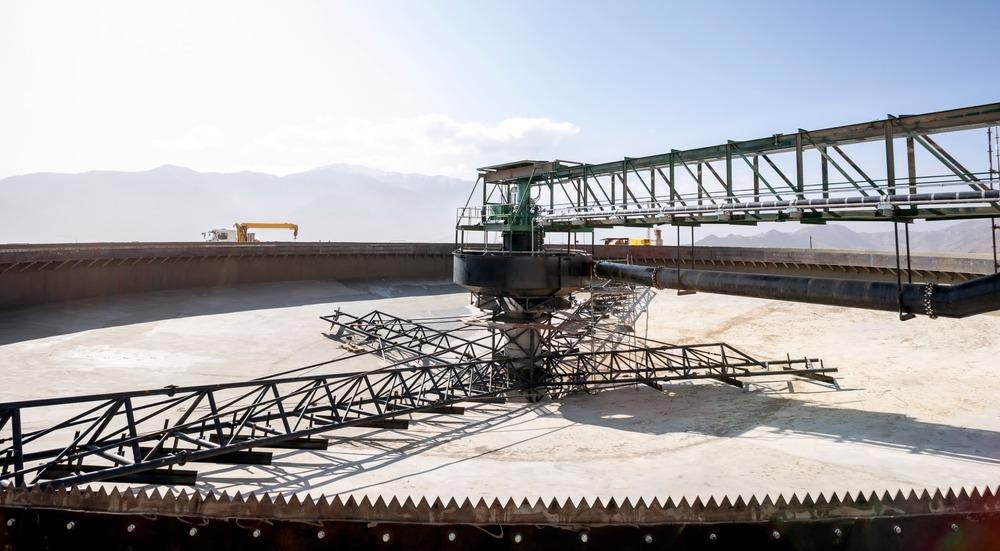Thickeners are essential in mineral processing facilities and have been used for many decades. In recent years, there has been a growing recognition of the importance of refurbishing and retrofitting thickener technology in the mining industry to improve sustainability.

Image Credit: Funtay/Shutterstock.com
Improving Mining Sustainability
Sustainability is a key focus in the mining and mineral processing industries. Dwindling mineral resources and the sector’s greenhouse gas emissions have led to an interest in sustainable technologies and processes.
Mine tailings present environmental challenges due to potential pollution, with heavy metals and other toxic materials leaching into groundwater and fragile ecosystems, and wildlife exposure.
Tailings also present the risk of landslides, with disasters such as Aberfan in 1966, where 144 people were killed when mining debris collapsed, and covered buildings built in its shadow. Dust can be deposited onto nearby communities, and numerous instances of dam failures in tailings ponds have occurred over the decades. Tailings can also limit the operational ability of mines and impact their economic viability.
Mining and mineral processing also uses vast amounts of energy and resources such as water. Facilities make use of several technologies to reduce their energy and resource needs.
Thickeners are one example of a technology that helps to improve the sustainability of the mining and mineral industries. Improving mining sustainability is especially crucial in regions that experience high water stress.
What are Thickeners?
Thickeners are used in mining operations and mineral processing facilities to separate water from tailings or concentrates.
Aside from recovering valuable minerals, they are widely used to treat wastewater, sludge and waste residues, and for mine water management and recycling.
Separated water can be reused for operational purposes, and the tailings can then be stored or backfilled. Industries such as metallurgy, non-metallic mineral processing, coal, and environmental protection utilize thickeners.
Flocculants are added to raw materials introduced into a thickener. Solid particles settle in the tank due to the activity of flocculants and gravity, leaving a sludge at the bottom of the tank and clarified water on top of this layer. This enables efficient separation of the soil materials and liquid. Rakes continuously scrape the sludge at the bottom of the thickener tank to the bottom of the pool where it is discharged, with water flowing over the edge of the tank.
There are three types of thickeners currently used in the mining industry: ordinary thickeners, high-efficiency thickeners, and inclined plate thickeners.
Ordinary plate thickeners are the most widespread in use worldwide. Various considerations govern the choice of thickeners such as concentration, material properties, viscosity, and processing capacity.
Refurbishing and Retrofitting Thickeners
Improving the performance of mining equipment and infrastructure is crucial to keep up with the demands of the industry.
Modernizing crucial mining and mineral processing equipment is key to meeting the sustainability aims of the sector, and thickener technology is constantly evolving. Refurbishing and retrofitting thickeners is therefore vital to provide enhanced performance and sustainability.
Retrofitting and refurbishing thickener equipment provides several benefits for the industry. Firstly, extending the lifetime of equipment saves costs and materials compared to installing completely new equipment.
Retrofitting and refurbishing improve the profitability and environmental footprint of operations. Sustainability is enhanced through benefits such as improved underflow density, which improves residence time and resource recovery with fewer resource needs.
Case Study: FLSmitdh’s Sustainable Thickener Technologies
FLSmidth is a provider of innovative solutions to the global mining and cement industries. Its MissionZero sustainability program aims to help these industries achieve their net-zero targets.
The company helps reduce water use and the carbon footprint of mining operations by developing solutions that improve performance, reliability, and availability and do not impact the environment.
Recognizing the value of refurbishing and retrofitting thickener technology, FLSmidth has been working closely with companies in the mining and mineral processing sectors. They have developed technologies such as the E-Volute feedwell, which increases retention time, reduces overflow solids, evens slurry and solid distribution, maximizes throughput, and increases equipment capacity.
The company has recently been working with one of Australia’s largest gold mines to upgrade its thickener technology. Work includes upgrading the mine’s leach feed thickener with their E-Volute feedwell and E-DUC dilution system.
This increased the system’s underflow density, reducing the need for cyanide and lime in the thickening process and increasing residence times. This also reduces the amount of flocculants needed in the thickening process.
FLSmidth has made several recommendations to improve the efficiency of thickener equipment and processes at the mine, leading to enhanced sustainability of operations and profitability for the mine.
Within 12 months, payback was achieved. Implementing the company’s recommendations increased plant capacity by 9%. Gold production was increased without additional ore requirements.
The Future of Thickener Reuse and Retrofitting
Improving the sustainability and profitability of mining operations and mineral processing is a key concern in the 21st century.
Reusing and retrofitting equipment such as thickeners is crucial to meet the environmental obligations of the sector and will ensure its continued economic viability in the future.
Innovation is driving this progress and will continue to do so in the coming decades.
References and Further Reading
Murphy, E (2022) Thickener upgrade: where financial and sustainability overlap [online] australianmining.com. Available at: https://www.australianmining.com.au/
Longzhong Machinery (2022) What is a Thickener in Mining? [online] lzzgchina.com. Available at: https://www.lzzgchina.com/solutions/project-case/what-is-a-thickener-in-mining.html
Miningpedia (2020) Commonly Used Mining Thickener Types and Selection [online] mininpedia.cn. Available at: https://www.miningpedia.cn/thickening-dewatering/commonly-used-mining-thickener-types-and-selection.html
Disclaimer: The views expressed here are those of the author expressed in their private capacity and do not necessarily represent the views of AZoM.com Limited T/A AZoNetwork the owner and operator of this website. This disclaimer forms part of the Terms and conditions of use of this website.